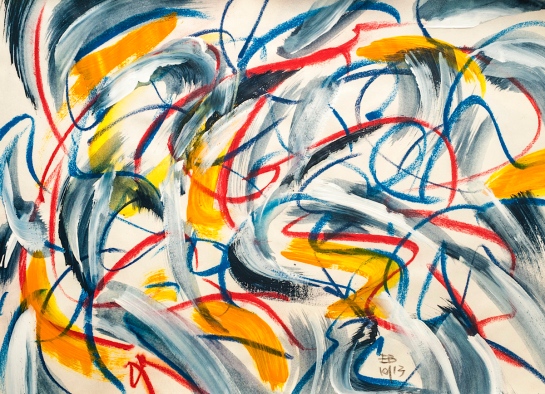I’ve had three Canson A3 (appx. 16 x 12 inches in size) 100-page sketchbooks “on the go” since early 2013, two of them more or less filled now with what I think of as “expressive abstractions” using acrylic paint, watercolour, Conté crayon, soft pastel and oil-crayon… sometimes combining more than one as in mixed-media.
Around a dozen have been for sale on my ETSY shop https://www.etsy.com/shop/SketchBuzz? for the past year amongst other works (around 40 pieces to date) with compositions and colour combinations more easy on the eye, as well as larger pieces of more recognisable subjects… and four, maybe five, have sold… although not anything resembling the above scribble.
I use the word “scribble” because that is what this is… daubs of different acrylic colours with wax crayon overlaid afterward, all in random strokes which, now I can recall more clearly, was one of more than a dozen similar works made shortly before my wife died last November after a very lengthy illness. Was I influenced, or frustrated, by what was happening in my personal life? Probably!
When I try to do similar work now – by allowing my mind and hand to wander in sympathy, although not necessarily synchronicity – I’m hesitant and feel I cannot achieve the same freedom. At the moment the only conclusion I can come to is that artistic scribbling is not very easy to do… despite what casual viewers will imply when mentioning their children’s primary school efforts during art lessons.
But I know there is more to it than that, and a number of artists have achieved world-wide fame, or notoriety, with artwork which has evolved in styles which baffle many people… there being nothing new with that when one considers how Impressionism, or many of the other -isms, created shock and horror at the time because they changed and challenged the accepted safe concepts of art. However, two artists I admire greatly are Joan Mitchell and Cy Twombly…
Notes from TheArtStory.org… “Joan Mitchell is known for the compositional rhythms, bold coloration, and sweeping gestural brushstrokes of her large and often multi-paneled paintings. Inspired by landscape, nature, and poetry, her intent was not to create a recognizable image, but to convey emotions. Mitchell’s early success in the 1950s was striking at a time when few women artists were recognized. She referred to herself as the “last Abstract Expressionist,” and she continued to create abstract paintings until her death in 1992.
Inspired by the gestural painting of Willem de Kooning and Franz Kline, Joan Mitchell’s mature work comprised a highly abstract, richly colored, calligraphic manner, which balanced elements of structured composition with a mood of wild improvisation.
Mitchell rejected the emphasis on flatness and the “all-over” approach to composition that were prevalent among many of the leading Abstract Expressionists. Instead, she preferred to retain a more traditional sense of figure and ground in her pictures, and she often composed them in ways that evoked impressions of landscape.
Mitchell’s abrasive personality has been a key factor in interpretations of her painting, which critics often read as expressions of rage and violence. Yet, almost as often, they have seen lyricism in her work.”
And from CyTwombly.info… “Some writers have concentrated on the materiality of the artist’s mark as aggressive, often illegible graffiti; others have followed the classical allusions to ferret out the references. Two elements might serve as metaphors for the predominant interpretations… However, Twombly’s painterly palimpsests trace the progressions through which form and content, text and image are inextricably linked.
Cy Twombly arrived in Manhattan in 1950 while the New York School painting of Pollock and de Kooning was in full swing. Upon Robert Rauschenberg’s encouragement, Twombly joined him for the 1951–1952 sessions at Black Mountain College near Asheville, North Carolina – a liberal refuge, a site of free experimentation and exchange in a nation growing increasingly conservative during the Cold War. Among the influential teachers present at this time were Charles Olson, Franz Kline, Robert Motherwell and John Cage. Building on the freedom afforded by the previous generation, the younger artists emphasised libidinal energy integrated through experience.
They focused attention on calligraphic gesture and word/image relationships resulting in work that was more syncretic, less spontaneously automatist.In the statement, Twombly describes his process: “Each line is now the actual experience with its own innate history. It does not illustrate – it is the sensation of its own realisation.”
With their works achieving millions at auction, can I put mine on ETSY or Saatchi Art, my two sales sites, for a hundred or so dollars? Or, as Malcolm Gladwell in “Outliers” wrote, “…researchers have settled on what they believe is the magic number for true expertise: ten thousand hours.” do I need to do those 10,000 hours of pure, creative and expressive work before I can get away with my scribbles? There are many creative types who think you do, and the Ten Thousand Hours website at http://www.10khrs.co show this with a recorded interview series about craft, creativity and putting in our time.
Image © 2014 Ed Buziak


